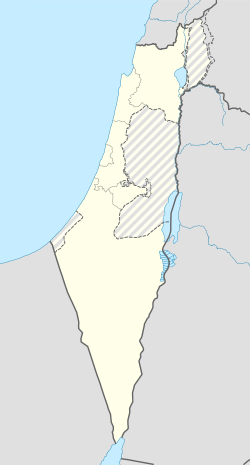Ein Vered
In this article we will explore Ein Vered, a topic that has captured the attention of many people in recent years. Ein Vered has been the subject of debate in society, generating a wide range of opinions and perspectives. As Ein Vered continues to be relevant in today's world, it is important to examine different aspects related to this topic. Through this article, we will explore different points of view and analysis to provide a comprehensive view on Ein Vered. In addition, we will analyze its impact in different areas and how it has evolved over time. This article seeks to shed light on Ein Vered and promote a deeper understanding of its importance today.
Ein Vered
עֵין וֶרֶד | |
|---|---|
 | |
| Coordinates: 32°15′56″N 34°56′0″E / 32.26556°N 34.93333°E | |
| Country | Israel |
| District | Central |
| Council | Lev HaSharon |
| Affiliation | Moshavim Movement |
| Founded | 1930 |
| Founded by | Tel Aviv residents |
| Population (2022)[1] | 1,564 |

Ein Vered (Hebrew: עֵין וֶרֶד, lit. 'Rose Spring') is a moshav in central Israel. Located in the Sharon plain, it falls under the jurisdiction of Lev HaSharon Regional Council. In 2022 it had a population of 1,564.[1]
History
Before the 20th century the area formed part of the Forest of Sharon. It was an open woodland dominated by Mount Tabor Oak, which extended from Kfar Yona in the north to Ra'anana in the south. The local inhabitants traditionally used the area for pasture, firewood and intermittent cultivation. The intensification of settlement and agriculture in the coastal plain during Ottoman rule in the 19th century led to deforestation and subsequent environmental degradation.[2]
Ein Vered was established in the southern Sharon in 1930, by South African Jewry on land purchased by the Jewish National Fund,[3] and named after 'Ayun el Werdat (Arabic for "the Springs of the Water Female Water Drawers"),[4] the wells serving the area. It was originally an intensive farming community.[3] In 1947 it had a population of 450.[3]
Citrus groves, field crops, beehives and flowers were the principal branches of agriculture.[5]
Landmarks
A Tractor Museum is located in Ein Vered.[6]
References
- ^ a b "Regional Statistics". Israel Central Bureau of Statistics. Retrieved 21 March 2024.
- ^ Marom, Roy (2022-12-01). "The Oak Forest of the Sharon (al-Ghaba) in the Ottoman Period: New Insights from Historical- Geographical Studies". Muse. 5: 90–107.
- ^ a b c Jewish National Fund (1949). Jewish Villages in Israel. Jerusalem: Hamadpis Liphshitz Press. p. 40.
- ^ Conder, C. R. (Claude Reignier); Palestine Exploration Fund; Kitchener, Horatio Herbert Kitchener; Palmer, Edward Henry (1881). The survey of Western Palestine : Arabic and English name lists collected during the survey. Robarts – University of Toronto. London : Committee of the Palestine Exploration Fund. p. 173.
{{cite book}}: CS1 maint: publisher location (link) - ^ Farming history blooms in May
- ^ Israel Tractor Museum

